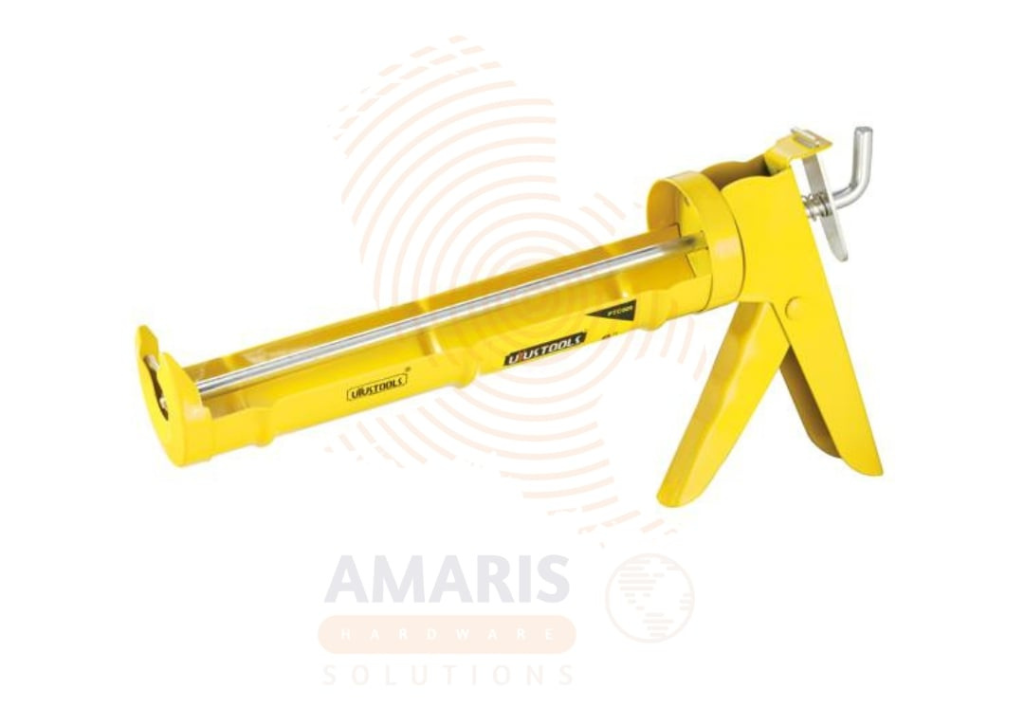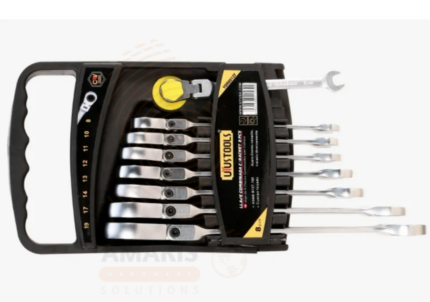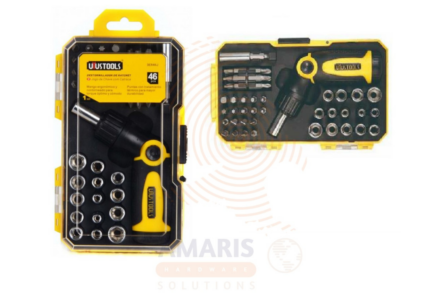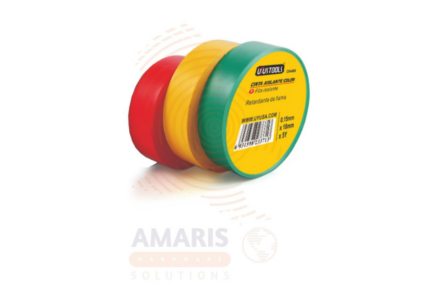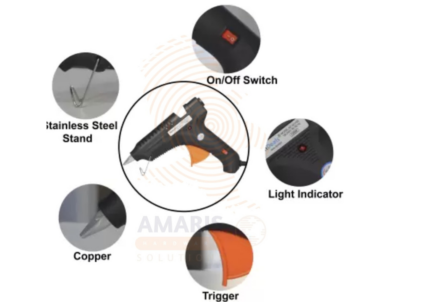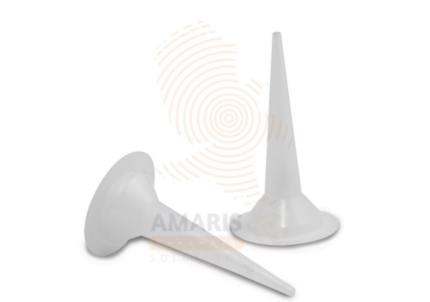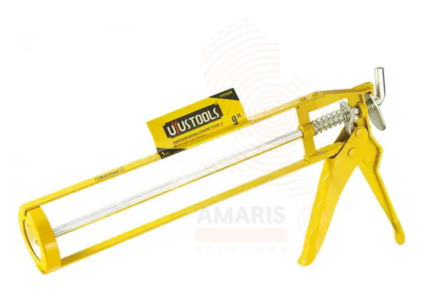Ratchet Rod Caulk Gun
WhatsApp Order
- Ratchet Rod:
- A ratchet rod is not a widely recognized term for a specific tool. However, a ratchet is a mechanical device that allows continuous linear or rotary motion in one direction while preventing motion in the opposite direction. If you are referring to a tool with a ratcheting mechanism used for a specific purpose, additional context would be needed.
- Caulk Gun:
- A caulk gun is a handheld tool used in construction and home improvement for applying caulking or sealant. It typically consists of a frame, a trigger, and a rod. The caulking cartridge is loaded into the gun, and when the trigger is squeezed, the rod advances, pushing the caulking material out through the nozzle for precise application.
Description
Table of Contents
ToggleRatchet Rod Caulk Gun
Uses
-
Sealing Gaps and Joints: Caulk guns are primarily used to seal gaps and joints in various materials, such as between walls and baseboards, around windows and doors, and in bathrooms and kitchens.
-
Waterproofing: They are used to apply waterproof sealants around windows, doors, and other openings to prevent water infiltration.
-
Weatherproofing: Caulk guns help in weatherproofing by sealing gaps in exterior walls and preventing drafts, thus improving energy efficiency.
-
Construction and Repairs: In construction, caulking guns are used to seal joints in various building materials, providing durability and structural integrity. They are also essential for repairs, such as fixing leaks or filling cracks.
-
DIY Projects: Caulk guns are commonly used in do-it-yourself (DIY) projects for tasks like installing crown molding, repairing drywall seams, or any project that requires sealing gaps.
-
Adhesive Application: Some caulking guns can be used to dispense adhesive or glue, making them versatile for various bonding applications.
-
Painting: Caulk guns are sometimes used to apply paint or other coatings in a controlled and precise manner.
SAFETY HANDLING PRECAUTIONS
Safety Precautions
-
Read the User Manual:
-
Familiarize yourself with the manufacturer's instructions and safety guidelines provided in the user manual for the caulking gun.
-
-
Personal Protective Equipment (PPE):
-
Wear appropriate personal protective equipment, such as safety glasses and gloves, to protect your eyes and hands from caulk or sealant.
-
-
Inspect the Tool:
-
Before use, inspect the caulking gun for any damage or wear. Ensure that all parts, including the ratchet or dispensing mechanism, are in good working condition.
-
-
Select the Right Caulk:
-
Choose the correct type of caulk or sealant for the specific application. Different projects may require different formulations, so refer to the manufacturer's recommendations.
-
-
Secure Work Area:
-
Ensure a clean and well-ventilated work area. Remove any potential tripping hazards and make sure the surfaces are stable.
-
-
Loading and Unloading:
-
Follow proper procedures for loading and unloading caulk cartridges. Be cautious when inserting or removing cartridges to avoid accidental dispensing.
-
-
Controlled Dispensing:
-
Squeeze the trigger gradually to control the flow of caulk. Avoid excessive force, as it may lead to uneven application or wastage.
-
-
Cleaning and Storage:
-
Clean the caulking gun promptly after use to prevent dried caulk buildup. Store the tool in a dry and secure location, away from children or unauthorized users.
-
-
Dispose of Waste Safely:
-
Dispose of used caulk cartridges and waste materials in accordance with local regulations. Some caulks may have specific disposal requirements.
-
-
Emergency Preparedness:
-
Be aware of the location of emergency equipment, such as a first aid kit, and know the procedures for handling accidental exposure to caulk or other emergencies.
-
Related products
Caulk Gun
A caulk gun, also known as a caulking gun or a sealant gun, is a hand-held tool designed for dispensing and applying caulking or sealant materials. It typically consists of a metal or plastic frame with a trigger mechanism, a rod to advance the caulk cartridge, and a nozzle for precise application. The caulk gun is commonly used in construction, home improvement, and various maintenance projects to seal gaps, joints, or seams in order to prevent air, water, or pests from infiltrating a structure.
Coloured Insulating Tape
Coloured insulating tape is a flexible adhesive tape used primarily for electrical insulation and wire identification. Made from durable materials like PVC, it provides excellent resistance to abrasion, moisture, and varying temperatures. The tape comes in multiple colours to allow easy colour-coding of electrical wires and cables, enhancing safety and organization in electrical installations.
Double Sided Tape
Double-sided tape is a type of adhesive material that has adhesive on both sides, allowing it to adhere to two surfaces simultaneously. It typically consists of a thin, flexible backing material with adhesive coatings on both sides, protected by release liners that are removed before application. This tape is commonly used for bonding two surfaces together, providing a discreet and often temporary means of attachment without the need for traditional fasteners like nails or screws. Double-sided tape is versatile and comes in various strengths and designs to suit different applications, ranging from lightweight mounting to heavy-duty bonding.
Glue Gun
A glue gun, specifically a 40-watt glue gun, is a handheld tool designed for dispensing hot melt adhesive in a controlled and precise manner. It typically consists of a heating element powered by a 40-watt electrical system, a trigger mechanism to control the adhesive flow, and a nozzle for directing the melted glue. The glue stick, usually made of thermoplastic materials, is inserted into the gun, melted by the heating element, and then extruded through the nozzle as a liquid adhesive. This versatile tool is commonly used in various DIY projects, crafts, and home repairs due to its quick and efficient bonding capabilities. The 40-watt power rating indicates the electrical power consumed by the glue gun to heat the adhesive to its melting point.
Plastic Nozzle for Aluminum Caulking Gun
A Plastic Nozzle for Aluminum Caulking Gun is a detachable dispensing tip or extension made of plastic that is designed to be attached to the end of an aluminum caulking gun. This nozzle serves as the outlet through which caulk or sealant is dispensed, allowing for precise application and control of the material. The plastic construction of the nozzle ensures compatibility with various types of caulks and sealants, and it is typically designed for easy cleaning and reuse. The combination of a plastic nozzle with an aluminum caulking gun provides a durable and versatile tool for applying sealants in construction, home improvement, or other similar applications.
Skeleton Caulk Gun
A "skeleton caulk gun" refers to a type of caulk gun that features a skeletal or open-frame design. Unlike standard caulk guns, which have a solid body enclosing the caulk tube, a skeleton caulk gun has a minimalistic structure with an open frame that allows the user to see the caulk cartridge inside. This design provides better visibility of the caulk level, making it easier for the user to monitor and control the application of caulk. Skeleton caulk guns are commonly used in construction and home improvement projects for sealing joints and gaps with precision.
Teflon Thread Sealing Tape
A Teflon thread sealing tape, also known as plumber's tape or PTFE tape (polytetrafluoroethylene tape), is a thin, white, non-sticky tape used to seal threaded pipe joints. It is commonly employed in plumbing and pipefitting applications to create a tight and leak-free seal between threaded connections, such as those found in pipes, fittings, and valves. The tape is wrapped around the threads of the male pipe before it is screwed into the female fitting. Teflon tape provides lubrication for easier assembly while forming a seal that helps prevent leaks and enhances the integrity of the connection. The non-stick properties of Teflon make it resistant to sticking or binding when the joint is later disassembled.


 Acrylic Sealants
Acrylic Sealants Construction Adhesives
Construction Adhesives Double-Sided Tape
Double-Sided Tape Duct Tape
Duct Tape Electrical Tape
Electrical Tape Epoxy & Resins
Epoxy & Resins Masking Tape
Masking Tape
 Automotive Wrenches & Socket Sets
Automotive Wrenches & Socket Sets Battery Chargers & Jump Starters
Battery Chargers & Jump Starters Car Jacks & Stands
Car Jacks & Stands Car Wash & Detailing Products
Car Wash & Detailing Products Diagnostic Tools
Diagnostic Tools Tire Inflators
Tire Inflators Vehicle Lighting
Vehicle Lighting Oil & Lubricants
Oil & Lubricants
 Adhesives & Sealants
Adhesives & Sealants Bricks & Blocks
Bricks & Blocks Cement & Concrete
Cement & Concrete Drywall & Plaster
Drywall & Plaster Flooring (Tiles, Wood, Laminate)
Flooring (Tiles, Wood, Laminate) Lumber & Plywood
Lumber & Plywood Paints, Primers & Coatings
Paints, Primers & Coatings Insulation Materials
Insulation Materials Roofing Materials
Roofing Materials
 Circuit Breakers
Circuit Breakers Electrical Cables & Wires
Electrical Cables & Wires Switches & Sockets
Switches & Sockets Fuses & Relays
Fuses & Relays Connectors & Terminals
Connectors & Terminals Electrical Boxes & Panels
Electrical Boxes & Panels Conduit & Fittings
Conduit & Fittings Lighting Fixtures & Bulbs
Lighting Fixtures & Bulbs Extension Cords & Power Strips
Extension Cords & Power Strips
 Anchors
Anchors Bolts
Bolts Clips & Clamps
Clips & Clamps Screws
Screws Nuts
Nuts Washers
Washers Rivets
Rivets Nails
Nails Threaded Rods
Threaded Rods
 Hammers
Hammers Measuring Tools (Tapes, Levels, Calipers)
Measuring Tools (Tapes, Levels, Calipers) Screwdrivers
Screwdrivers Pliers & Cutters
Pliers & Cutters Saws & Blades
Saws & Blades Chisels & Punches
Chisels & Punches Allen Keys & Hex Keys
Allen Keys & Hex Keys Ratchets & Socket Sets
Ratchets & Socket Sets Wrenches & Spanners
Wrenches & Spanners
 Power Tool Accessories (Blades, Bits, Discs)
Power Tool Accessories (Blades, Bits, Discs) Rotary Tools
Rotary Tools Saws (Circular, Jigsaw, Reciprocating)
Saws (Circular, Jigsaw, Reciprocating) Drills & Drivers
Drills & Drivers Grinders & Sanders
Grinders & Sanders Heat Guns
Heat Guns Nail Guns
Nail Guns Impact Wrenches
Impact Wrenches Batteries & Chargers
Batteries & Chargers
 Pipes & Fittings (PVC, Copper, PEX)
Pipes & Fittings (PVC, Copper, PEX) Plumbing Tools
Plumbing Tools Pumps & Motors
Pumps & Motors Sealants & Adhesives for Plumbing
Sealants & Adhesives for Plumbing Valves & Taps
Valves & Taps Water Heaters
Water Heaters Drainage Systems
Drainage Systems Faucets & Fixtures
Faucets & Fixtures Hoses & Tubing
Hoses & Tubing
 Hinges & Latches
Hinges & Latches Hooks & Brackets
Hooks & Brackets Window Hardware
Window Hardware Chains & Cables
Chains & Cables Casters & Wheels
Casters & Wheels Shelving & Storage Systems
Shelving & Storage Systems Door Handles & Locks
Door Handles & Locks Drawer Slides & Cabinet Hardware
Drawer Slides & Cabinet Hardware
 Personal Protective Equipment (PPE)
Personal Protective Equipment (PPE) Respirators & Masks
Respirators & Masks Safety Glasses
Safety Glasses Safes
Safes Security Cameras
Security Cameras Gloves
Gloves Helmets
Helmets Ear Protection
Ear Protection Fire Safety Equipment
Fire Safety Equipment Locks & Padlocks
Locks & Padlocks Motion Sensors & Alarms
Motion Sensors & Alarms
 Garden Fencing
Garden Fencing Garden Furniture Hardware
Garden Furniture Hardware Lawn Mowers
Lawn Mowers Trimmers & Edgers
Trimmers & Edgers Shovels & Spades
Shovels & Spades Rakes & Hoes
Rakes & Hoes Pruning Shears & Loppers
Pruning Shears & Loppers Watering Systems (Hoses, Sprinklers, Nozzles)
Watering Systems (Hoses, Sprinklers, Nozzles)
 Interior Paints
Interior Paints Paint Brushes & Rollers
Paint Brushes & Rollers Paint Strippers & Thinners
Paint Strippers & Thinners Paint Trays & Accessories
Paint Trays & Accessories Exterior Paints
Exterior Paints Spray Paints
Spray Paints Primers & Undercoats
Primers & Undercoats Varnishes & Stains
Varnishes & Stains
 Gaskets & Seals
Gaskets & Seals Hydraulic Fittings
Hydraulic Fittings Industrial Fasteners
Industrial Fasteners Industrial Hoses
Industrial Hoses Lubricants & Greases
Lubricants & Greases Metal Sheets & Bars
Metal Sheets & Bars Bearings & Bushings
Bearings & Bushings Belts & Pulleys
Belts & Pulleys
 HVAC Filters
HVAC Filters Insulation for HVAC
Insulation for HVAC Air Conditioners
Air Conditioners Refrigerants
Refrigerants Ventilation Ducts & Fittings
Ventilation Ducts & Fittings Thermostats & Controllers
Thermostats & Controllers Fans & Blowers
Fans & Blowers
 Pegboards & Hooks
Pegboards & Hooks Shelving Units
Shelving Units Storage Bins & Containers
Storage Bins & Containers Toolboxes & Tool Chests
Toolboxes & Tool Chests Workbenches
Workbenches Drawer Organizers
Drawer Organizers Labeling Supplies
Labeling Supplies
 Welding Accessories (Clamps, Brushes)
Welding Accessories (Clamps, Brushes) Welding Electrodes & Rods
Welding Electrodes & Rods Welding Helmets & Gloves
Welding Helmets & Gloves Welding Machines
Welding Machines Soldering Irons & Stations
Soldering Irons & Stations Flux & Solder Wire
Flux & Solder Wire
 Generator Accessories
Generator Accessories Inverters
Inverters Portable Generators
Portable Generators Power Inverters
Power Inverters Transfer Switches
Transfer Switches Diesel & Gasoline Generators
Diesel & Gasoline Generators
 Transport Equipment: Carts, Dollies, and Hand Trucks
Transport Equipment: Carts, Dollies, and Hand Trucks Storage Solutions: Pallets, Racks, and Containers
Storage Solutions: Pallets, Racks, and Containers Lifting Equipment: Hoists, Cranes, and Jacks
Lifting Equipment: Hoists, Cranes, and Jacks Conveyors and Accessories: Belts and Rollers
Conveyors and Accessories: Belts and Rollers